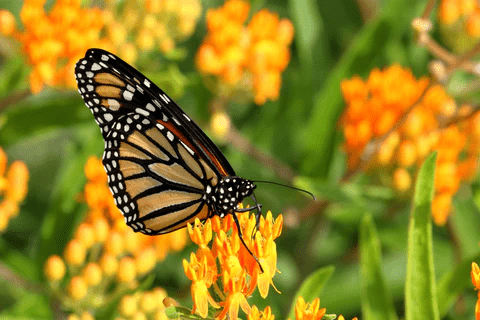Pollinator gardens seem so…last year’s garden. However, pollinator gardens play a large role in today’s horticulture for many reasons. The loss of pollinators, including honeybees, birds, bats, butterflies, moths, flies, wasps, beetles, and small mammals, play a critical role in our food production system. A healthy pollinator population is vital to producing marketable commodities such as fruits, nuts, vegetables, legumes and forage crops. More than 100 U.S. grown crops rely on pollinators. The added revenue to crop production from pollinators is valued at $18 billion. Pollinators also support healthy ecosystems needed for clean air, stable soils, and a diverse wildlife. The decline of 45.5% of managed honeybee colonies within the last 15 years is attributed to multiple factors. Many articles have been written on the effect of diseases, pesticides, pollutants/toxins, habitat loss, effects of climate variability, agricultural production intensification, and pollinator or crop management practices. Pollinator gardens by introducing plants and flowers in urban areas can help with the loss of habit and increase local fruit tree and vegetable garden production.

Careful planning is essential to successful pollinator gardens. While flowering plants can grow in both shady and sunny locations, consider your audience. Butterflies and other pollinators like to bask on bare ground spots in the sun and some of their favorite wildflowers grow best in full or partial sun with some protection from the wind. Both plants and pollinators need water, but pollinators need standing water. Providing birdbaths or areas for mud puddling are essential to the pollinator. Also, remember to think about more than just the summer season. Pollinators need nectar early in the spring, throughout the summer and even into fall. But during the winter months, they also need places to live, procreate and tend to the lives of their offspring. Selecting the proper plants that do well in your soil and sunlight conditions will help ensure your plants thrive. Select plants that haven’t been treated with pesticides or neonicotinoids. Native plants are the ideal choice because they require less maintenance and tend to be heartier.
Successful pollinator gardens have a mixture of perennials and annuals, flowers and bushes. For selection of plants, Milkweed is a staple among pollinator gardens. It provides an abundance of pollen and a surplus of nectar to attract and keep pollinators returning. Plains Sage (salvia coccinea) is another great source of pollen and nectar. It has the added advantage of being a lovely bushy plant blooming near the end of May. Blackberry bramble vines also produce a lovely summer fruit, as well as spring flowering. Butterfly bushes are a beautiful summer bloom that attracts many types of pollinators in addition to butterflies. Winter jasmine bush blooms in the winter and spring and has a heady scent to attract late pollinators. This bush provides winter home protection to pollinators in the pupal and larval stages. Year round, the Witch Hazel bush creates a holistic environment for all types of pollinators in various life stages and should be a staple in all pollinator gardens. Some wonderful native flowers to include in a pollinator garden are Asters, Beebalm (wild bergamot), Black-eyed Susans (rudbeckia), Blanket flower (Gaillardia), Primroses, daffodils, coreopsis, and many of the different sages (salvias) and sunflowers, just to name a few. Many of these bulbs or flower seeds will remain dormant for the first year, or can be planted in the late fall to bloom the following spring or summer.

Fortunately in Enid, we have several of the best sources of native pollinator garden suppliers around. Check out Johnston Seed Company at 319 West Chestnut and Plants a Plenty at 622 E. Cambridge, off of N. 4th Street. Additionally, the OSU Botanical Gardens in Stillwater frequently have seeds and bulbs harvested to give away. As always you may want to check out some of the most recent news about pollinators, pollinator gardens and native plants through the OSU Extension Office Fact Sheets either at the Garfield County Extension Office at 316 E. Oxford Ave. or on the website extension.okstate.edu/fact-sheets






